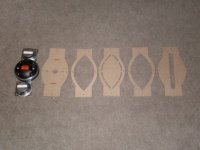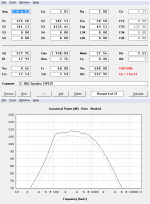I read pieces of the 'square pegs' thread. I found out it is not that easy, i can not see the resemblance between a paraline and a horn. The horn expands gradually, the paraline does not do that, looking at the pictures. How would a paraline for a basshorn look like in real life ( i mean dimensions, radius etc...).
I am not really getting it for the moment, i can see the soundwave travel through the 'disc', bend around the corner and the go back to the middle, i just can't see how it is expanding as a horn, in my eyes the soundwaves just travel a certain distance through the paraline? Thanks for the help!
JLH, it is a small world after all, i live close to Gent, about 100 km from Charleroi.
I am not really getting it for the moment, i can see the soundwave travel through the 'disc', bend around the corner and the go back to the middle, i just can't see how it is expanding as a horn, in my eyes the soundwaves just travel a certain distance through the paraline? Thanks for the help!
JLH, it is a small world after all, i live close to Gent, about 100 km from Charleroi.
The paraline expands radially. Its profile lays between a conical and parabolic expansion. The Youtube video for the Danley SBH-10 explains this fairly well. The big advantage I see using a paraline in a midbass horn is the limited (approx 10 degrees) vertical dispersion. This would eliminate floor and ceiling bounce. Construction is actually very easy considering the long wave lengths and dimensions needed for midbass frequencies. A paraline consists of 5 layers. (see attached picture) For the horn model I posted above anything between 18mm and 19mm thick material could be used. The paraline would be around 75cm tall and 37.5cm wide.
An externally hosted image should be here but it was not working when we last tested it.
Attachments
Oliebaron:
You could also try a variation of the BD design ORELINO ( Netherlands ) I think it is a pretty slick design using an open baffle horn and compression driver. You could possibly use two 12" woofers instead of 15" woofers to cut down of the width a bit.
You could also try a variation of the BD design ORELINO ( Netherlands ) I think it is a pretty slick design using an open baffle horn and compression driver. You could possibly use two 12" woofers instead of 15" woofers to cut down of the width a bit.
powerful little horn - 30 watts 120+dB 2pi down to 114Hz on sims - hope it gets built. speaking of hope, - hope 12pe32 is a good match for RCA-fan's 70Hz folded horn.
The B&C Speakers 12PE32 is the best cost effective 12" woofer for horn loading currently on the market. You'll not find another woofer for horn loading at a better price.
Oliebaron:
You could also try a variation of the BD design ORELINO ( Netherlands ) I think it is a pretty slick design using an open baffle horn and compression driver. You could possibly use two 12" woofers instead of 15" woofers to cut down of the width a bit.
As i look at the orelino,witch is a beautiful design, the horn is back loaded, or do i have to see it as a open baffle with wings?
If changed to a front loaded design, one could close the back of the woofers, but i suppose, even with 2 15 inch woofers per side, the horn would be fairly large and deep to go low enough to consider it full range?
Last edited:
Oliebaron:
I would give Bert ( BD design ) a call or better yet a visit if you live close enough.
As you know, all speaker designs are a compromise and "small' and horns do not go together !!!! I would guess that using proper multiple 10", 12" or 15" woofers you could make a similar design to fit your space. The lower the frequency you want the bigger the speaker system you need. However, using DSP and bi-amping could be used to your advantage.
I would give Bert ( BD design ) a call or better yet a visit if you live close enough.
As you know, all speaker designs are a compromise and "small' and horns do not go together !!!! I would guess that using proper multiple 10", 12" or 15" woofers you could make a similar design to fit your space. The lower the frequency you want the bigger the speaker system you need. However, using DSP and bi-amping could be used to your advantage.
JLH! I've had my Synergy/Paralines for almost 2 years now, and finally got a "real" woofer section in place to go with the horns. I considered many options.....horns, sealed, ported, ppsl, cardioid, etc but for some reason the Paraline didn't even cross my mind yet I see them everyday (I ended up with 2 TD15m sealed per channel). I may have to give it a shot. Does the Paraline hold directivity down to the wl supported by the slot height or does it go lower? I've yet to get good vertical measurements of mine.....
As I understand it from Tom, if you build a paraline where the height is twice that of the width, then the vertical dispersion will only be about 10 degrees. The horizontal dispersion is controlled by the angle of the horn or waveguide attached to the paraline. The frequency where the horn will lose directivity is the same for all horns (F = K/Ha*Xm). This can be found in Don Keele’s AES paper for the 58th convention, or on page 17 of the Synergy horn patent.
I worked out the major parts of a Paraline midbass horn using the B&C Speakers 12PE32 woofer. A straight horn like this would have had an overall length of 113cm (44.5"). With the paraline the overall length shrinks to just 83cm (32.625"). The -6dB points in half space (floor loading only) simulate out from 100Hz to 1180Hz. In real life it will never reach that high. The usable upper limit will be something closer to 650Hz.
Can you provide a rough sketch or plan of this design (or preferably a description of how to interpret the sim as a paraline profile). I could use such a design but am having a hard time visualizing how this sim translates to a paraline and an attached horn section.
Thanks
Wow, this paraline midbass is really something. Might be exactly ideal for my horn system (I'd like to cover from 500-600hz down to sub/bass bin so ~80hz ideal but 100hz ok). I am still pretty amateur with hornresp, but I've used it a few times before to simulate my horns. I'll have to read up on the design to see if I can figure this out.
One question though, can you play with the height width at all to change the polars a bit. I'm ok with 30" tall, but 10º seems pretty tight, was thinking 22.5 x 20" still have the same mouth area.
I guess the second question is still the time alignment still goes out the window like with folding, I'd assume?
One question though, can you play with the height width at all to change the polars a bit. I'm ok with 30" tall, but 10º seems pretty tight, was thinking 22.5 x 20" still have the same mouth area.
I guess the second question is still the time alignment still goes out the window like with folding, I'd assume?
I'll try to sketch something up in the next few days. I'm still playing around with adjustments and the fine details.
Josh, yes time alignment would change per the folding. 10 degrees isn't as narrow as you might think. If you already start with a 30" tall source and angle so its not firing into your knees, by the time it reaches the listening position the vertical dispersion should plenty big enough. A scaled room sketch should answer if it would need it to be bigger.
Josh, yes time alignment would change per the folding. 10 degrees isn't as narrow as you might think. If you already start with a 30" tall source and angle so its not firing into your knees, by the time it reaches the listening position the vertical dispersion should plenty big enough. A scaled room sketch should answer if it would need it to be bigger.
I am very interested in this design for sure.
I may start build something similar this winter and I like this B&C Speakers 12PE32.
I may start build something similar this winter and I like this B&C Speakers 12PE32.
I am curious to see this one play out. I was amazed at what the paraline did with 5" drivers. Seeing as I already have el-cheapo line arrays I naturally thought of these as upgrades after seeing Tom's video.
Is the 30" overall (includes horn shell, paraline, and woofer back chamber) acceptable to most people? The low frequency performance starts to suffer when I try to make it any shorter.
Here are the Horn Response input parameters. In 1/2 space (grey line) its -6dB point is 104Hz. In 1/4 space (dark line) the -6dB point moves down to 95Hz. The Paraline will be 73cm tall. Mouth is basically 20" by 32". The vertical dispersion angle will be about 20 degrees. I have not worked out what the horizontal would be yet.
Attachments
-6dB @ 104Hz for Pi loading (at junction of floor and wall).
starts to roll off at ~200Hz.
Are you saying that the roll-off from 200Hz to 104Hz is not audible?
starts to roll off at ~200Hz.
Are you saying that the roll-off from 200Hz to 104Hz is not audible?
Sim looks good.
I would be interested in seeing how it pans out. I even happen to have a spare pair of 12PE32's.
I would be interested in seeing how it pans out. I even happen to have a spare pair of 12PE32's.
- Status
- Not open for further replies.
- Home
- Loudspeakers
- Multi-Way
- full range horn system

